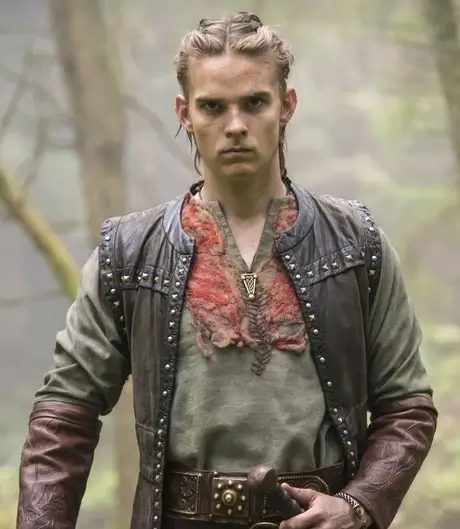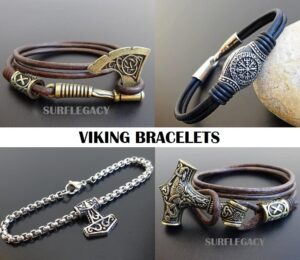If you’re a fan of the History Channel’s hit series Vikings, then you’re likely familiar with the complex and fascinating character of Hvitserk Ragnarsson. As the youngest son of the legendary Viking warrior Ragnar Lothbrok, Hvitserk has often been overshadowed by his more well-known brothers.
However, his story is just as compelling, with his journey as a warrior, leader, and ultimately a conflicted and troubled figure, making for some of the most gripping moments in the show’s run.
In this blog post, we will delve into the life and legacy of Hvitserk Ragnarsson, exploring his character in the Vikings series, his role in Viking history, and his enduring impact on popular culture.
Hvitserk Ragnarsson – Early Life and Family Background
Hvitserk Ragnarsson was born in the late 8th century, the son of legendary Viking leader Ragnar Lothbrok and his second wife, Aslaug Sigurdsdottir.
He was the youngest of their four sons, and his siblings were Ivar the Boneless, Bjorn Ironside, and Sigurd Snake-in-the-Eye.
Hvitserk’s mother was known for her clairvoyant abilities and was believed to be the daughter of the legendary hero Sigurd from the Volsunga Saga.
Hvitserk Ragnarsson Viking Campaigns
In the early 9th century, Hastein and Björn Ironside were two of the most notorious and successful Viking raiders. They jointly organized numerous expeditions to France, many of which were successful.
Like his brothers, Hvitserk was a skilled warrior and a leader in Viking campaigns. He is first mentioned in the sagas during the attack on Paris in 845 AD, where he fought alongside his brothers.
Hastein was also the mastermind behind a daring plan that would make Björn the emperor of Rome. Together, they led an expedition to the Mediterranean, where they attacked the city of Luni, mistaking it for Rome.
Despite being unable to breach the city walls, they devised a clever plan to infiltrate the city. Hastein sent a message to the city’s bishop claiming that he had converted to Christianity on his deathbed and asked for the bishop’s help in administering the sacraments and burying him on consecrated church land.
With the bishop’s assistance, Hastein was carried into the chapel, where he rose from his stretcher and opened the city gates for the Vikings, allowing them to capture the city.
Although this account of Hastein and Björn’s exploits is historically problematic, as Hastein appears in sources from a later period than Björn and the city of Luni was likely conquered by Saracens, not Vikings, it remains a popular and enduring legend.
The tale of Hastein’s deception and cunning in infiltrating Luni has been retold countless times in popular culture, and has come to represent the Viking spirit of adventure, daring, and cunning.
Hastein and Björn’s joint expeditions to France and the Mediterranean were also significant for their enduring impact on Viking history and culture, as they helped to establish the Vikings as a dominant force in the region, and set the stage for further Viking expansion and exploration.
Role in the Great Heathen Army
In the 860s, Hvitserk and his brothers returned to the Viking army, which had invaded England as part of the Great Heathen Army.
They fought against the Anglo-Saxon kingdoms of Northumbria, East Anglia, and Mercia, and were eventually victorious.
Hvitserk’s brother, Ivar the Boneless, was said to be the leader of the Great Heathen Army, but Hvitserk played a significant role in its success.
Later Life
After the conquest of England, Hvitserk’s whereabouts and activities are unknown for a time.
However, in the 870s, he appears in the sagas again, this time fighting against his own brothers. According to legend, Hvitserk and another brother, Sigurd Snake-in-the-Eye, joined forces and killed their brother, Ivar the Boneless, in revenge for his role in their father’s death.
Later, Hvitserk was said to have left England and traveled to the Mediterranean again, where he fought against the Moors in Spain.
Legacy
Hvitserk Ragnarsson’s legacy is less well-known than that of his brothers, Bjorn Ironside and Ivar the Boneless. However, his exploits in the Mediterranean and his role in the Great Heathen Army demonstrate his skill and prowess as a Viking warrior.
While his legacy may not be as well-known as that of his brothers, Hvitserk’s story adds an interesting dimension to the Viking age and its myths and legends.
Hvitserk character in the History Channel’s Vikings series
In addition to his role in Viking history, Hvitserk Ragnarsson has also been featured prominently in the popular television series Vikings on the History Channel.
The show presents an interpretation of his character and story, which has both similarities and differences to the historical record.
In this section, we will explore Hvitserk’s character in the Vikings series and how it compares to his real-life counterpart.
Background and Family
In the Vikings series, Hvitserk is the youngest son of Ragnar Lothbrok and his second wife, Aslaug. He is introduced as a child, along with his brothers, and is depicted as having a close relationship with his brother Ubbe.
However, he is also shown to be somewhat of a wild child, often getting into trouble and causing mischief.
Viking Campaigns
Like his historical counterpart, Hvitserk is portrayed as a skilled warrior and leader in Viking campaigns.
In the early seasons of the show, he fights alongside his brothers in the conquest of England as part of the Great Heathen Army.
He is shown to be a fierce fighter and a trusted member of the army, often engaging in hand-to-hand combat with the enemy.

Later Life
In the later seasons of Vikings, Hvitserk’s character goes through a significant transformation. After the death of his brother, Sigurd Snake-in-the-Eye, he becomes increasingly unstable and prone to violent outbursts.
He also becomes disillusioned with the Viking way of life and begins to question his own loyalties and beliefs.
This culminates in his conversion to Christianity and his decision to leave the Viking world behind. Hvitserk becomes a monk and spends several years in prayer and contemplation, trying to come to terms with his past and find a new purpose in life.
However, he is eventually drawn back into the world of the Vikings, where he once again engages in battles and political intrigue.
Comparison to the Historical Record
While Hvitserk’s character in the Vikings series shares some similarities with the historical record, there are also significant differences.
For example, in the show, Hvitserk is portrayed as having a much more central role in the conquest of England than he likely did in real life.
He is also given a more complex and nuanced personality, with his struggles with identity and morality being a significant focus of his character arc.
Additionally, the show’s depiction of Hvitserk’s conversion to Christianity and his subsequent return to the Viking world is entirely fictional.
There is no evidence in the historical record that Hvitserk ever converted to Christianity, and it is unlikely that he would have been welcomed back into the Viking community after abandoning their way of life.
Hvitserk’s impact on popular culture
Hvitserk Ragnarsson’s impact on popular culture has been significant, particularly as a result of his portrayal in the Vikings series. Since the show’s premiere in 2013, Hvitserk has become a fan-favorite character, with his complex personality and troubled journey resonating with viewers.
As a result, Hvitserk has gained a dedicated following and has become a popular subject of fan art, cosplay, and other forms of fan engagement.
Moreover, Hvitserk’s legacy has extended beyond the realm of Vikings fans, with his character influencing the broader cultural landscape.
The show’s portrayal of Hvitserk as a warrior struggling with issues of identity and morality has been praised for its nuanced depiction of mental health and trauma.
This has helped to raise awareness of the importance of mental health and mental wellness, and the need to destigmatize mental health issues.
Hvitserk’s impact can also be seen in the wider popular culture sphere, with the character inspiring numerous spin-offs, adaptations, and merchandise.
For example, the success of Vikings has led to the creation of several spin-off shows, including Vikings: Valhalla, which is set to premiere on Netflix. Hvitserk has also been featured in various video games, including the popular mobile game Vikings: War of Clans.
Additionally, Hvitserk’s legacy has helped to bring greater attention to Viking history and culture. The show’s portrayal of Viking society, customs, and traditions has sparked a renewed interest in the Viking Age, with many fans seeking to learn more about this fascinating historical period.
This has led to an increase in Viking-themed tourism, with fans traveling to historic Viking sites and events to learn more about the culture that Hvitserk and his contemporaries lived in.
Conclusion
Hvitserk Ragnarsson’s character in the Vikings series is a fascinating and complex interpretation of his historical counterpart.
While the show takes significant liberties with his story, it provides an engaging and entertaining portrayal of a Viking warrior struggling to find his place in the world.
Whether or not it accurately reflects the real-life Hvitserk, it adds an interesting layer to his legacy and helps to keep his story alive for a new generation of viewers.




